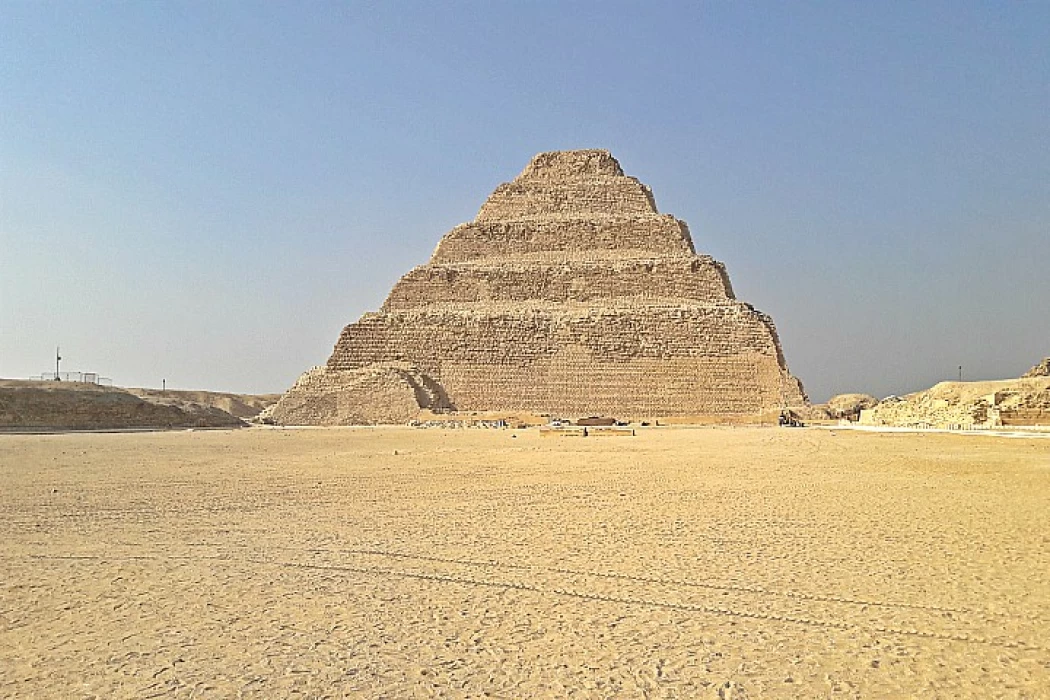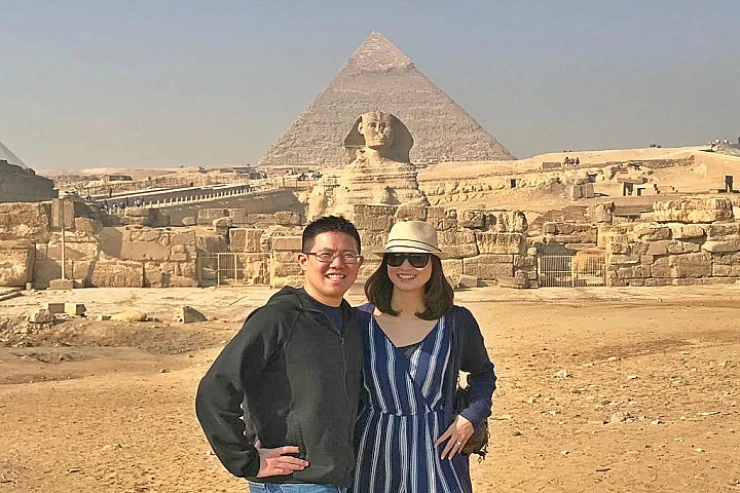The Step Pyramids of Djoser: A Landmark in Ancient Egyptian Architecture
The Step Pyramid of Djoser stands as one of the most iconic and influential structures in ancient Egyptian architecture. Located in the Saqqara necropolis, about 30 kilometers south of Cairo, this remarkable edifice is not only the oldest known pyramid but also a groundbreaking architectural achievement that marks a significant evolution from earlier burial practices. Commissioned during the Third Dynasty of the Old Kingdom by Pharaoh Djoser, this pyramid symbolizes a pivotal moment in the history of ancient Egypt.
Historical Context
The Step Pyramid was constructed during the reign of Pharaoh Djoser, who ruled from around 2670 to 2640 BCE. Djoser’s reign is considered a period of significant innovation and consolidation in early dynastic Egypt. The Step Pyramid complex at Saqqara was designed by Imhotep, the chief architect and vizier, whose genius in design and engineering has left an indelible mark on the history of architecture.
Architectural Innovation
The Step Pyramid of Djoser represents a dramatic departure from earlier burial structures. Before this, the predominant form of royal burial was the mastaba—a rectangular, flat-roofed tomb with sloping sides. The Step Pyramid, however, introduced a new architectural concept with its six distinct tiers or steps, each one receding from the one below it, creating a stepped appearance.
Design and Construction:
Structure: The pyramid initially began as a simple mastaba, but Djoser’s vision led to its expansion into a six-tiered pyramid, standing approximately 62 meters high. The base of the pyramid covers about 109 by 125 meters, showcasing its vast scale.
Materials: Constructed primarily of limestone, the Step Pyramid’s design involved massive quantities of stone, illustrating the advanced quarrying and construction techniques of the time. The use of dressed stone blocks, rather than mudbrick or other materials, represented a significant technological advancement.
Innovations: Imhotep’s design was revolutionary for its time. The use of a series of progressively smaller mastabas stacked on top of each other was a precursor to the smooth-sided pyramids that would follow. This stepped design also provided a grand, ascending path that symbolized the pharaoh's journey to the divine.
The Complex and Its Features
The Step Pyramid is the centerpiece of a larger mortuary complex that includes several other significant structures:
The Mortuary Temple: Adjacent to the pyramid, this temple features intricate carvings and inscriptions, providing insights into the religious and ceremonial practices of the period. It was designed for the performance of rituals and offerings to the deceased king.
The Serdab: This is an enclosed chamber within the complex, which housed a statue of Pharaoh Djoser. The serdab was designed to allow the king’s ka (spirit) to observe and receive offerings from the living.
The Courtyards and Enclosures: The complex features an extensive array of courtyards, walls, and structures that served both ceremonial and practical purposes. The intricate design of these enclosures reflects the complexity of the religious and cultural practices surrounding the burial of a pharaoh.
Cultural and Historical Significance
The Step Pyramid of Djoser represents a monumental leap in Egyptian architecture. It marks the transition from the early mastaba tombs to the iconic pyramid structures of the Fourth Dynasty, such as those at Giza. Its design paved the way for future developments in pyramid construction, influencing the architectural innovations that followed.
Imhotep, the architect of the Step Pyramid, was deified in later periods, and his contributions were celebrated as exemplary of wisdom and engineering prowess. The Step Pyramid’s design and construction set a new standard for royal tombs, blending architectural sophistication with religious symbolism.
Located in the vast expanses of Saqqara in the outer suburb of Cairo, the Step Pyramid of Djoser is indeed one of the strongest, yet most ancient, structures that Egypt boasts about. Often regarded as the first structure to implement large-scale stone construction techniques, this monumental building can be said to have spearheaded the era of pyramid construction in ancient Egypt. Built over 4600 years ago, the mysterious construction with a wide array of shapes, stories, and usages still exists and inspires archeologists, historians, and tourists to this day.
Historical background and significance
The Step Pyramid, otherwise referred to as the Pyramid of Djoser, was constructed in the 27th century BCE under the reign of the Pharaoh Djoser, who was the second monarch of Egypt's Third Dynasty. Djoser was a progressive king who wanted something more than apostolic vertical graves—mastabas—that man who is into a flat-topped tomb design created for a range of other pharaohs, including his steps. He commissioned the project to his most trusted architect, Imhotep, whom history would remember for far greater things than mere architecture.
Imhotep, who was an architect ahead of his time and the high priest, aspired to build a monument that was not only grand in the eyes of the Pharaoh but would also see a safe flight to Osiris. To achieve this, he invented a new architectural design, which was known as a step pyramid, by vertically stacking six nesting mastabas of increasingly smaller size. This great edifice not only served to elevate the status of Djoser in death but also transformed the architectural landscape of ancient Egypt forever.
The Step Pyramid measures around 62 meters (203 feet) in height, and it was the highest structure back then. Imhotep set a new trend in construction by building the pyramid with stone instead of mudbrick, which was used before. The pyramid is made up of six levels, or steps, each of which rises toward the peak of the structure, forming a staircase that is believed to help the king’s spirit ascend to heaven.
The pyramid complex is quite spacious, covering about 15 hectares (37 acres) and surrounded by a limestone wall with 14 false doors and one real door. This ingenious design had both symbolic and functional value, as it shrouded the pharaoh’s burial place in an aura of mystery and secured him from any invaders. Once inside the enclosure, one can find dozens of different buildings, such as temples and courtyards as well as the South Tomb, all of which are meant to help the deceased king reach the other world as well as serve religious practices.
Impressive underground tunnels form one of the exceptional aspects of the Step Pyramid complex. The vast stretch of 5.7 km (3.5 miles) of these vaults has more than 40, 000 stone jars engraved with the names of other kings before Djoser. The painstaking detail in the arrangement of these tunnels speaks volumes about the ideas of the ancient Egyptians concerning the protection of the treasures of the king for all time.
Imhotep, who came up with the concept of the Step Pyramid, was a Renaissance man qualified in several fields, including architecture, medicine, and religion. Because of his involvement in building the Step Pyramid, he received a lot of fame and respect. He was so influential that he was treated like a god of medical and healing arts more than a century after his death. His innovative way of using stones for construction made way for the enormous pyramids that would come after, such as the Great Pyramid of Giza.
Imhotep's design for the Step Pyramid complex also shows how much he grasps engineering with religion. The superficial step structure of pyramids represents a symbol of ascending toward the gods for the pharaohs, while the inner courtyards and temples are a representation of the cultural aspects of ancient Egyptian society rituals. This ability to balance the need for functional design and altar design envisioning the mass-transforming power of spirits reaffirms his place as one of the best architects in history.
Religious and cultural importance
Step Pyramid is a representation of sacredness in the sense that it is both a tomb and, in this case, a door to another dimension of life. The pharaohs were believed to be the people who could mingle with the gods and, thus, were considered divine. In connection with this, Djoser built the Step Pyramid to protect his divine status as well as ensure that his spirit would traverse safely into other planes of existence.
The course of the pyramid complex construction is accurate in that it shows cardinal directions and contains elements associated with the transport of the great pharaohs. The South Court, which is a large region devoid of any enclosing interior wall, was most likely enlarged in anticipation of the Heb-Sed celebration, which was a ritual that granted legitimacy to the king and spelled his right to rule. This was an opportunity for Djoser to ascertain himself as still living and well, even after he had been buried.
Furthermore, the other enclosing chapels and temples were also built for the priests, who were responsible for conducting the daily ceremonies to the spirit of Djoser, the king, and feeding him for his eternal journey. Such a practice of worshipping the dead in this manner emphasized the unending cycle of life, death, and rebirth, as was the case with the ancient Egyptians, which characterized their way of life.
The Djoser's Step Pyramid laid the foundations for a new generation of pyramids with smooth surfaces that dominated ancient Egyptian architecture. The success of Djoser’s monument brought on the following pharaohs, who commissioned larger and larger pyramids, which resulted in the Giza pyramids.
The Step Pyramid made a few improvements that would later be typical in the design of pyramid complexes. Many of these construction elements—stone quarrying, basement burial chambers, and the giant scale of the structure—were factors that pioneered the development of building pyramids. Djoser’s Step Pyramid is probably the main reason why such enormous pyramids as those of Sneferu, Khufu et al. were constructed.
For many generations, the Step Pyramid remained the symbol of the architectural accomplishment of the ancient Egyptians, but with time, it underwent much erosion. Starting from the year 1900, one British archeologist by the name of Cecil Firth made his way to Saqqara and commenced excavation works, which led to the discovery of most of the structures in the pyramid complex. Over the years, some other excavators have also managed to do a little more work at this remarkable structure.
Recently, however, restoration work has been carried out to restore the Step Pyramid for posterity. The extensive work involves, among other things, the stabilization of the internal chambers and the reconstruction of the outer walls. Such projects thankfully aim to compromise as little as possible on the original purpose of the building and allow this landmark building to testify for even more years about the culture and history of the country.
Visiting the Step Pyramid Today
Currently, tourists visiting Djoser’s Step Pyramid can enjoy not just the structure itself but the entire complex, which also reveals the elements of ancient Egyptian art and religion. Entering through the stone doors and strolling around the open sections, one can almost feel the presence of a bygone era dominated by Kings and the making of everlasting structures.
Nevertheless, Saqqara’s Step Pyramid is also one of the top places to see for every traveler, every historian, and every admirer of the undying civilization of Ancient Egypt. It is a monument of Pharaoh Djoser’s dreams as well as of the genius called Imhotep, the wonder that mankind still looks up to even after 4600 years of its existence.



















